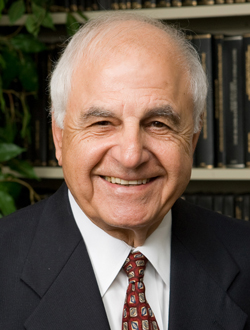George I. Haddad

 Enlarge
Enlarge
Prof. George I. Haddad served the department as Chair for a total of 19 years. He left a remarkable legacy of achievement and leadership in research, teaching, service and administration at Michigan ECE that spans over half a century.
Originally from Lebanon, Haddad came to the University of Michigan in 1952 as an undergraduate student. Upon receiving his bachelor’s degree in 1956, he worked for a short time at Motorola in Chicago, but ultimately returned to U-M to pursue more schooling.
After receiving his master’s degree in 1958, Haddad was convinced to stay for his PhD by renowned professor and chair, William Gould Dow, who appreciated his gift for communication in addition to his research skills. So he stayed, and upon graduation, Dow (chair of the department from 1960-65) hired him as an assistant professor in 1963 (he was already on staff as in Instructor as of 1961).
When his former thesis advisor, Joseph Rowe, became department chair in 1968, Haddad took over from Rowe as Director of the Electron Physics Laboratory (EPL). This was a very challenging time for the lab, and Haddad had to show his resourcefulness amidst funding limitations and changes in staffing. His leadership helped ensure the future of the lab, garnering significant funding in the area of solid-state electronics and hiring key faculty members like Professor Ken Wise.
Haddad’s research was focused on microwave devices, and finding ways to get them to generate the highest frequencies possible at relatively high power levels and efficiencies. As a master’s student, he built the first X-Band traveling wave maser in the world. Masers, which preceded lasers, were used for low noise amplifiers in such applications as receiving signals from satellites.
While his PhD work focused on microwave tubes, he quickly shifted to the new area of solid state devices. This move, combined with his charge as EPL director, led Haddad to build up the area of microwave solid-state devices and integrated circuits. Michigan has remained a leader in these fields ever since.
When Rowe left the University in 1975, Haddad again took over his position; this time as chair of the department. Finances were still very tight, enrollment in ECE was exploding by the late 70’s, funding for the department was down, and the national ranking had dropped out of the top 10. Haddad got to work.
The department underwent sweeping changes during the 1980’s – most of them initiated, planned, and executed with Haddad at the helm. These changes included the new EECS building on North Campus, which housed a state-of-the-art Solid-State Electronics Laboratory, the hiring of several dozen faculty, the formation of the EECS Department from three entities and subsequent restructuring of the curriculum, and a virtual explosion of new research centers and funding. Haddad credited Dean Duderstadt with revitalizing the entire College of Engineering and allowing significant numbers of new faculty to be hired.
In 1986, Haddad stepped down as chair, and simultaneously established the Center for High Frequency Microelectronics (CHFM). Funded at $15M by the Department of the Defense, with an additional $5M from the state, the CHFM essentially doubled the research funding in the department. Twelve other faculty were involved in the Center.
The CHFM opened new research avenues for graduate students, including state-of-the-art millimeter wave integrated circuits, sub-0.1-micron field-effect transistor technology, advanced epitaxial growth technologies, optoelectronic devices and integrated circuits, and quantum-based electronic devices and circuits.
In 1991, Haddad was asked once again to step in as chair, the only second term in the department’s history. Among his accomplishments during this tenure was the continued hiring of excellent faculty, continual acceleration of research funding, and PhD student production that reached an all-time high. His final report on the status of the department in 1997 showed a very strong department, both in national rankings and in fiscal health.
After his final term as chair, Haddad continued his research as part of a Multidisciplinary University Research Initiative focused on Low Power/Low Noise Electronics. In this initiative, he explored the terahertz frequency range for chemical and biological sensing applications.
George Haddad retired in 2005 from the University of Michigan, but soon after agreed to work for NSF as a Program Directory in Communications, Circuits, and Sensing Systems (CCSS), which is part of the Electrical, Communications, and Cyber Systems Division (ECCS).
Haddad received the IEEE-MTT Distinguished Educator Award, the ASEE Curtis W. McGraw Research Award, the University of Michigan Distinguished Faculty Achievement Award, and the CoE Stephen S. Attwood Award. He is a Life Fellow of the IEEE and a member of the National Academy of Engineering.
His contributions to ECE are memorialized in the George Haddad Conference room in the EECS Building.
References and Further Reading
George Haddad Memoir (University of Michigan Faculty History Project)
 MENU
MENU 
